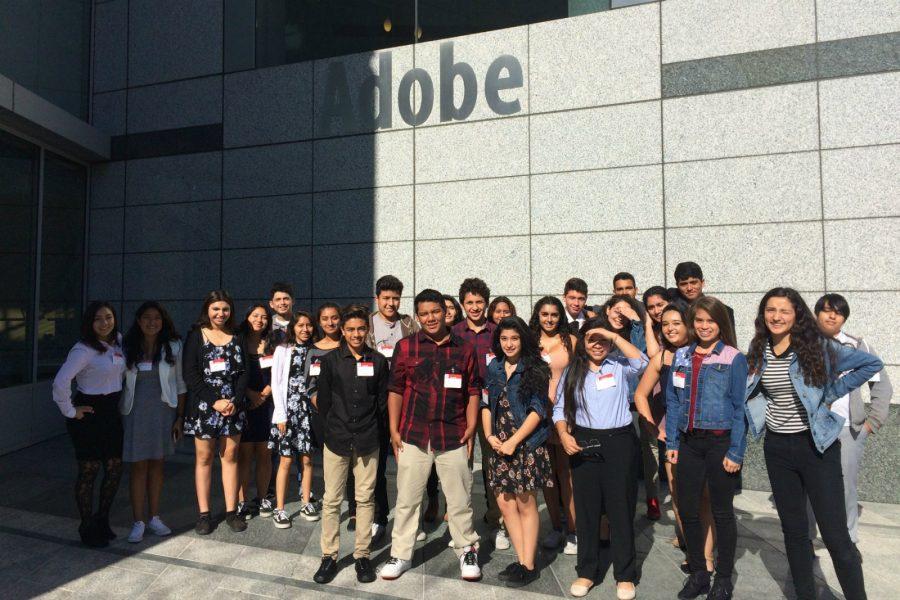School Board Sets Direction for Future
AVID students take a tour of the Adobe’s headquarters as part of the Four-Year Exploration program set up last year. Among other goals, expansion of the Exploration program is one of the MVLA School Board’s priorities this school year. Photo courtesy Keren Dawson-Bowman.
Through the 2016-2017 Action Plan, the MVLA School Board decided which issues it would prioritize as most important for the upcoming school year. They chose to focus on expanding the AVID Exploration program and increasing graduation requirement rigor and curriculum alignment.The school board is also currently in the process of constructing a facilities master plan that will detail how facilities will be utilized for the next 10 to 15 years. The school board created the last master plan in 1995, and they now seek to modernize facilities and accommodate student growth.
AVID Exploration program
From going on field trips to Adobe’s headquarters to touring El Camino Hospital, AVID sections this year have received plenty of exposure to the workplace, and the school board looks to further develop the AVID Four-Year Exploration program over the year. By hiring more AVID staff and expanding opportunities for junior and senior students, the school board aims to further expose AVID students to possible career options.
“Seeing someone who’s like you ten or twenty years from now helps you understand that the path to understand how to be successful isn’t always easy,” Superintendent Jeff Harding said. “When we look at the opportunity gap between high socioeconomic students and low socioeconomic students, one of the biggest gaps is exposure to a professional environment.”
While the program currently only offers field trips to different companies in Silicon Valley, Harding hopes to allow 11th grade students experience a short-term internship opportunity in a selected career field. In 12th grade, they aim for students to become more involved in long-term internships over the course of a couple weeks or during summer break.
“[In the future], 11th and 12th graders will have internship-type opportunities,” AVID teacher Keren Dawson-Bowman said. “In 11th grade, they will do more of a shorter-term internship experience, and then senior year, hopefully get to do a long-term internship experience.”
The school board has continuously provided funding for the AVID department to further develop the Exploration program. This year the school board hired more AVID staff and created more AVID sections to reduce the amount of work for parent volunteers and teachers and reduce class sizes.
Graduation rigor
For years, Los Altos baseline graduation requirements based on the California Education Code have remained constant: two years of math, two years of science, four years of English. However, that standard may see drastic changes in the near future. The school board plans to raise the rigor of graduation to increase students’ preparedness for college and beyond. In the coming months, they will begin discussions with student trustees and teachers on creating challenging graduation requirements.
“The minimum bar doesn’t prepare students for the world that they will enter when they leave high school,” Harding said. “We are going to set the bar higher for the student that comes into high school intentionally trying to do the least they can do to graduate.”
One possible revision may require students to complete three years of math and three years of science. For instance, instead of taking Algebra 1 to meet the graduation requirement, students could now also have to take Algebra 2 to graduate.
“This will have to be a board discussion that will involve our students and teachers,” Harding said. “But the possibility of requiring a third year of math or third year of science will be part of that discussion.”
Curriculum alignment
The school board, as part of a years-long process, has continuously looked to align various classes both in and out of the district. This year, the school board prioritizes two different types of alignment: alignment with middle school districts and alignment within the district.
In a process called vertical alignment, MVLA teachers look to standardize final exams in eighth-grade courses in feeder districts like LASD and Mountain View Whisman with final exams of the same classes at the high school level. By creating similar structure and rigor in courses from sixth to ninth grade, the school board hopes freshmen will be more prepared for the rigor of courses offered in the MVLA district.
“Teachers and staff are working with the feeder districts to [vertically align] courses,” school board member Debbie Torok said. “So if you graduate from Blach in Algebra 1 and come to the high school and take Geometry, then you’re just as well-prepared as a student who [is] coming from Graham or Crittenden.”
In addition, the school board aims for horizontal alignment, or making the difficulty of classes constant between teachers to create equitable experiences.
“The big picture is that a student who takes a course should have the same [experience] as in the [identical] course taught by a different teacher,” Harding said. “The graded materials should be the same, the homework load should be the same and the learning objectives should be the same.”
Facilities’ conditions
With the last facilities assessment conducted over 20 years ago, the MVLA School Board hired architecture firm Quattrochi Kwok Architects (QKA) to analyze the state of district facilities. At a school board meeting on October 10, QKA reported that most of the district’s buildings are in excellent shape, with minor issues such as adding directional signage and replacing worn roofs.
“All of the MVLA school sites are in really good shape,” QKA architect Debra McGuire said. “We do a lot of school districts, and some of them haven’t been able to get the kind of maintenance they need, and that is so not true [in this district].”
The school board will shape their longer-range facilities master plan around the assessment, which aimed to identify specific parts of buildings that weren’t functioning correctly and bring them to attention. At the earliest, the master plan will be completed by the end of the school year.
Toward the end of the first semester, teachers and architects will begin to discuss educational specifications, which stipulate how to design facilities to match educational programs. These specifications drive how facilities will be reformed, and can only come after a facilities assessment has detailed what’s deficient.
“Architects will come and meet with [staff] to see how they want to use their buildings, then [the architects] will design buildings to meet those needs,” Associate Superintendent Mike Mathiesen said. “Educational specifications drive how we’re going to touch [deficient buildings] and whether we’ll leave them the same or renovate them.”
The combination of the facilities assessment and the education specifications will lay the foundation for the master plan by assessing buildings that are out-of-shape and how to reform them.
Portables for student growth
Though the district’s facilities are in great shape, they do not suit the growing student population. According to Mathiesen, a demographic analysis predicted an increased population of 350 students in the district within the next six years, and next year Los Altos will have 70 more students than it can accommodate.
The district is looking at the possibility of ordering three portable classrooms to be ready by the start of the next school year as a short-term fix, and the master plan will determine possible long-term solutions.
Although the school board hasn’t made a decision yet, they are considering many possibilities for long-term solutions to growing student enrollment. Because there is little space for new classrooms, any new buildings would be two-story structures, which could also be created by adding second stories to existing wings.
“If we’re going to build classrooms, do you build up and build a two-story structure that takes up less of a footprint on the ground?” Mathiesen said. “Given that space is so limited, much of the construction would be two-story.”
The school board will discuss the topic further, and they have not decided on a single solution.
“In the long-term, we want an investment that we can sustain [and] is as inexpensive as possible,” MVLA School Board President Phil Faillace said. “We want buildings that are nice, safe, and promote student and teacher health and education.”

Legend says that if you reach deep enough into the inside pocket of Danny’s leather jacket, past the hordes of pens and six-sided dice moping dejectedly,...




